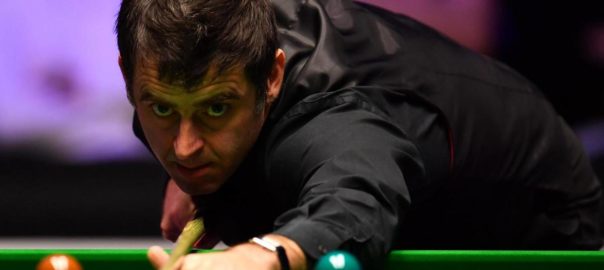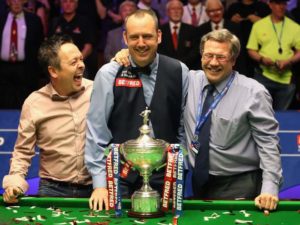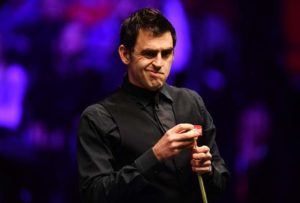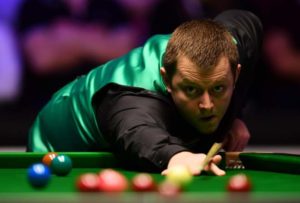The inventor of SightRight explains to Lawrence Ostlere what he can teach snooker’s greatest natural talent, how he deals with the sceptics, and reveals plans to conquer a host of other sports – even football
Article source: www.independent.co.uk
The snooker world first began taking Steve Feeney’s unique coaching methods seriously around the time Stuart Bingham won the 2015 World Championship. For a while Bingham had been just another journeyman with a shrinking hairline and an expanding waistcoat, so when he began playing the snooker of his life aged 39 to become the Crucible’s oldest first-time champion, the game took note.
Then there was Mark Williams. The Welshman had sat down with his wife at the kitchen table to discuss retirement before he sought out Feeney’s help; he soon won his first ranking title for seven years and within 12 months was transformed into a 43-year-old world champion.
The world titles of Bingham and Williams gave Feeney’s patented SightRight methods credibility in the face of much scepticism, and now the snooker world awaits the verdict of the game’s most natural talent. Ronnie O’Sullivan officially started working with Feeney over the summer, and won the Shanghai Masters in September before reaching the semi-finals of the English Open. There, in between critiques of the Crawley leisure centre’s distinct aroma, O’Sullivan produced a mesmerising maximum break in the second round reminiscent of his very best. “Ronnie’s loving it,” insists Feeney of his SightRight training.
SightRight works by correcting parallax error, a deception of perspective caused when inadvertently but consistently looking across the line of aim, rather than directly down the centre. It is a coaching method approved by World Snooker, and has proved most effective for older pros whose eye dominance has changed over time.
“Once you’re aiming from the perfect sighting position and set up to the shot with the correctly aligned technique, it’s like me giving you a gun that I’ve already set up, aimed perfectly, it cannot move,” explains Feeney. “All you have to do is pull the trigger, and as long as you squeeze that trigger correctly, it hits the spot. I can stand on the other end of the shot and I can steer a player into the shot perfectly just by knowing how they see straight.”
An obvious question at this point is to wonder why a master of the game like O’Sullivan would need to realign his technique. In a way Feeney’s forensic approach jars with the very idea of ‘the Rocket’, a man who plays on instinct and emotion, who operates outside the laws of physics which govern the rest of us and brings unpredictability to such a methodical game. But a truth of modern sport is that unadulterated natural talent no longer really exists. Gone are the days when Alex Higgins and Bill Werbeniuk could sink six pints before a match, and another one each frame. Sporting greatness now requires an obstinate will to improve, and perhaps the reality is that O’Sullivan’s sixth world title is going to take hard work, perseverance, even innovation.
“With Ronnie, he’s seen what’s happened with Mark Williams, with Bingham. And the best players in the sport like to stay ahead of the competition,” says Feeney. “If me working with Ronnie can keep him great for longer, that’s a great thing. People say: ‘Why would Ronnie ever need this?’. If Ronnie needs a proven method that he can transition to – well I see Ronnie as Nick Faldo: two years he worked on his swing, two years he was criticised, but the rest is history.”
It is a brave man to tell proven professionals they’ve been doing it wrong all their lives, but that is part of Feeney’s schtick. He requires an element of faith from his subjects as he shifts their entire perspective three inches to the left or right. The former world champion Shaun Murphy remembers the day he called Feeney over to his house, the year after he was beaten by Bingham in an epic 2015 final. Feeney arrived, unpacked his training gear and embarked on some testing. Murphy says he was stunned when the big reveal showed that what he thought was the centre of alignment was nowhere close – something Feeney calls “the eureka moment”.
“If you imagine the best in the world being proven that they’re off-line, that raises some big questions,” says Feeney. “It’s disruptive technology, a paradigm shift in the coaching world. It challenges the status quo. If you can keep proving and proving then in the end people can’t ignore. In the early days, any paradigm shift has to come with proof, more proof, more proof until the doubters – and Mark [Williams] was one – start saying ‘There must be something in this’.”
Williams once called SightRight ‘sight-wrong’, among other less polite rhymes used on the tour. One of the more outspoken cynics is Mark Allen, the world No12, who questioned whether too much credit is being sent Feeney’s way for the achievements of Williams and O’Sullivan, two of the all-time greats of the game. Allen once tried SightRight too, but said it wasn’t for him.
“If people try it, that’s one thing; if people work with me for a period of time, that’s another,” says Feeney. “Those people that are comfortable where they are, they will do the same old thing and their results won’t change. Those who want to be successful will change and do the right things.” Is SightRight not partly a mental reassurance, a kind of placebo effect? “Some say it’s all up top – I can’t agree with that. There are certain fundamental technical things that a player must have.”
Feeney is now broadening his horizons with an adaptation of SightRight for golf putting coaching. “Within the next two to four years I’ll probably have between 500 and 1,000 coaches across both [snooker and golf],” he says. He has also worked with professional darts players and has plans for basketball, cricket and even football, having already worked with a Championship striker. “With footballers it’s how they receive the ball, more accurate passing, more accurate striking, more accurate penalties. I can even find the flaws where the assistant referee is not seeing straight across an offside position. Parallax error comes across in football in quite a huge way.”
How far can SightRight spread? Feeney still has his snooker critics to persuade and much will depend on O’Sullivan; Feeney is well aware that the Rocket’s sixth world title would be the ultimate endorsement. The catch-22 of now working with one of the game’s greatest is that even if O’Sullivan wins at the Crucible in May, to claim his first world title for six years, there’s no proving he wouldn’t have done it anyway. What seems clear is that SightRight is effective for some and not so for others; Williams swears by it, one of 11 players on the tour using Feeney’s methods, a number which continues to swell.
Anyone who’s tried snooker knows the daunting feeling of standing over a vast 72 square-foot baize, on which a millimetre shift in how a pair of two-inch balls collide can produce a wholly unwelcome trajectory. Precision is everything, and so perhaps the most surprising thing about SightRight and its newfound competitors is that they didn’t take hold sooner. But then this is a sport that still requires polished shoes and a waistcoat, which still has its global pinnacle in a windowless room in Yorkshire, nostalgic traditions which make it an unlikely place for the epicentre of some kind of sport-wide coaching revolution.
Then again, perhaps that is why snooker is ripe for innovation. The basic tenets of technique still emanate from Joe Davis, the 15-time world champion of the 1930s and 40s. What if there was another whole level of biomechanical efficiency to be unearthed? And what if a player like O’Sullivan could harness it? For Feeney, 20 years after he first conceived of SightRight and in the face of all his doubters along the way, that would be the ultimate vindication. “What’s that phrase?” he says. “First they ignore you, then they laugh at you, then they attack you, then you win.”





